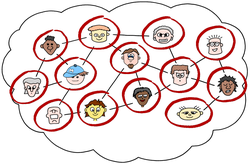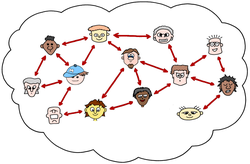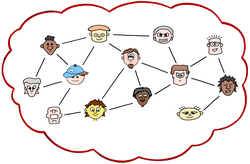How do you manage 8 people working on 20 projects, more or less at the…
Change Management 3.0
No matter how big the CEO’s desk is, an organization is not a hierarchy. It is a social network. People interact with each other across all levels. And even though delivering a software product is quite different from handing over the butter at the lunch table while you chitchat about the weekend, in both cases there are social networks involved. This makes every organization a complex adaptive system comprising individuals and their interactions within a certain environment.
Sometimes you would like to change something in that social network. Sometimes you want people to be nicer, more mindful, or better disciplined. Sometime you just want them to fill out a form, or give you some money.
When you want to change behaviors in something as complex as a social system, you have to understand the four aspects of change management:
First, Adapt to the System
A social network is a complex adaptive system. It will adapt to what you do, and so you must adapt continuously to how the system responds to your actions. It means you must be a systems thinker and understand how systems behave.
Second, Lead the People
 Understand that people are the crucial parts of the social system, and that all people are different. There’s no one-approach-fits-all. Diversity is what makes the social system work, and thus diversity is crucial in your approach when dealing with people.
Understand that people are the crucial parts of the social system, and that all people are different. There’s no one-approach-fits-all. Diversity is what makes the social system work, and thus diversity is crucial in your approach when dealing with people.
Third, Work the Network
 Understand how behavior spreads through the complex system. In a social network it is all about individuals and their interactions. Behaviors spread like viruses, and social network analysis can help to understand how to overcome resistance to change and transform an entire social system.
Understand how behavior spreads through the complex system. In a social network it is all about individuals and their interactions. Behaviors spread like viruses, and social network analysis can help to understand how to overcome resistance to change and transform an entire social system.
Four, Change the Environment
 Understand that self-organization always happens within a boundary. The environment determines how the system can self-organize, and you can tweak the environment. People’s behaviors depend on their environment. Therefore, if you change the environment you change the behavior of people.
Understand that self-organization always happens within a boundary. The environment determines how the system can self-organize, and you can tweak the environment. People’s behaviors depend on their environment. Therefore, if you change the environment you change the behavior of people.
The Change Management 3.0 Supermodel
Designers will find that most organizations can be considerably improved just within the context of the bounded design. This is because the barriers to change are usually in the decision-makers' own minds and in the organization itself.
– Michael P. Jackson, Systems Thinking
When you understand these aspects of change management, congratulations! You are able to apply the Change Management 3.0 supermodel. I call it a supermodel because it wraps a few smaller well-known models for change that each address one of the four aspects of change management:
- Adapt to the System (using the PDCA model)
- Lead the People (using the ADKAR model)
- Work the Network (using the Adoption Curve model)
- Change the Environment (using the 5 I’s model)
I will describe each of the four smaller models in subsequent blog posts. Once you understand the supermodel you will be in a perfect position to try and “make” people better disciplined, or ask them for money.



